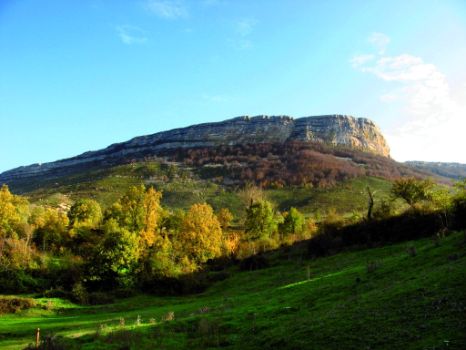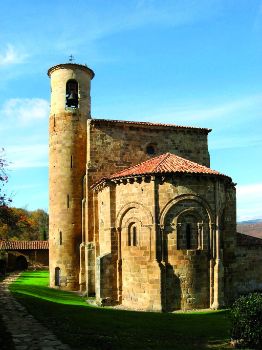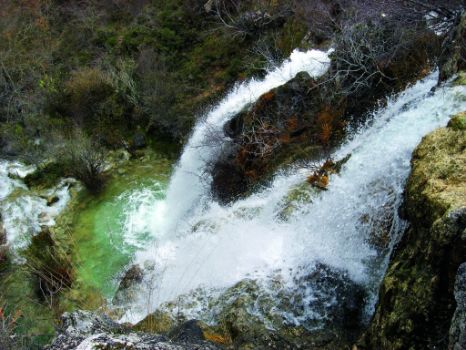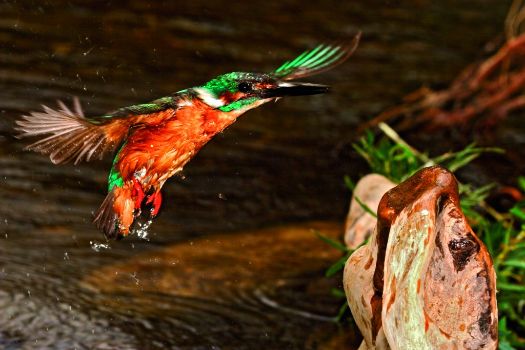Net of Natural
Trails

Stage 4: Polientes - Orbaneja del Castillo
Description
The route leaves Polientes (710 m) towards Rocamundo Bridge. After crossing the stream, it continues along a track through fields and gall oaks that leads to a bee farm in Mount La Mata de Arenillas. There are views of Ruijas along the route.

Further on, the route arrives at Arenillas de Ebro (4.4 km, 1hr 15min). Next to the 12th century Romanesque church of Nuestra Señora de Asunción is the way towards Villota de Elines, 1.5 km away. There is a path below the church that leads to San Martín de Elines (8.4 km, 2hr 25min).
The Collegiate Church of San Martín de Elines, a former 10th century Benedictine monastery with Mozarabic elements, may be visited (arrangements must be made with the priest or at the house opposite the church). Whereas the Romanesque church was built in the twelfth century, the cloister, which holds beautifully carved 13th century sarcophagi, was added in the 16th century. The exterior maintains its stately nature with its round tower and wonderful corbels.
The route winds down to the river, towards Barrio de Abajo, with good views of San Martín de Elines and the Collegiate, the high plateau of La Lora and Arroyuelos. The Nature Trail reaches the bridge over the Ebro, and without crossing, heads straight ahead along the right bank, next to a stone basin.

Past an abandoned religious building, the route reaches Villaescusa de Ebro and its bridge (11.8 km, 3hr 10min). The town is divided into two neighbourhoods connected by a paved road along the right bank of the Ebro. The folk-style church, although simple, is the most interesting architectural structure in Valderredible that has remained unchanged over time.
The route continues to the edge of the second neighbourhood, traversing fields and walls into an area populated with oaks, beeches and black poplars, where the Ebro narrows between crags. After crossing a concrete bridge over a stream, the route reaches Electra del Tobazo, where the track ends.
Leaving Electra del Tobazo to the left, the route follows the right bank of the Ebro (along the Camino Viejo de Orbaneja), traversing a landscape of oak trees, riparian vegetation and crags that flank the river.
Past Vertiente de Cabeza de Pedro Rapids, the route heads towards the boundary between Cantabria and Castille and León. Soon after, the vegetation thickens with holly trees, oaks and a small wetland near a reforestation pine forest with a rich diversity of protected birdlife.
Past the second meander, a bridle path from the high plateau joins the track, which now drifts away from the river, and begins to climb after leaving some magnificent oaks behind. The path moves towards the whimsical rock formations of El Castillo, from which Orbaneja takes its surname.

The vegetation is less dense and the landscape more open, with views of the town, which can be reached by a bridge over the road (660 m, 18.3 km, 4hr 55min). This enclave is considered one of the most beautiful in northern Spain owing to the blend of spectacular natural landscapes, folk touch -tufa stone streets, mountain-style houses, Romanesque church- and its karst system, which includes Middle Turonian dolomitic limestone caves, like the Agua, Barbancho or Níspero caves.
Entidades gestoras:
- Ministerio de Agricultura, Pesca y Alimentación
Enlaces de interés
Puntos de interés
Culture
Geology
Infrastructure
Municipality
Orography
Profile

Highlights
Further information
El Tobazo
Before reaching Electra del Tobazo, a path leads to the beautiful El Tobazo waterfall. The path climbs up a field to the base of the waterfall, and further on to the top. Erosion has carved numerous natural caves into this karst outcrop of tufa stone, which have been used as a hermitic retreat. At the very top is the pool from where the water spills over the waterfall.
Electra de Tobazo used this hydraulic power to light and supply water to the town of Valderredible. Now a privately owned property, it has been 25 years since it was last used for that purpose.






